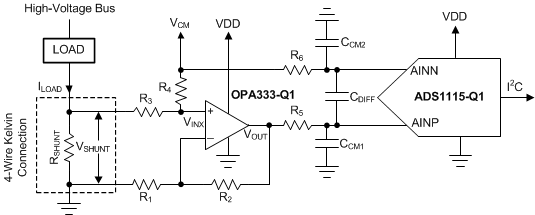ZHCSE76E December 2011 – December 2022 ADS1113-Q1 , ADS1114-Q1 , ADS1115-Q1
PRODUCTION DATA
- 1 特性
- 2 应用
- 3 说明
- 4 Revision History
- 5 Pin Configuration and Functions
- 6 Specifications
- 7 Parameter Measurement Information
- 8 Detailed Description
-
9 Application and Implementation
- 9.1 Application Information
- 9.2
Typical Application
- 9.2.1 Design Requirements
- 9.2.2
Detailed Design Procedure
- 9.2.2.1 Shunt Resistor Considerations
- 9.2.2.2 Operational Amplifier Considerations
- 9.2.2.3 ADC Input Common-Mode Considerations
- 9.2.2.4 Resistor (R1, R2, R3, R4) Considerations
- 9.2.2.5 Noise and Input Impedance Considerations
- 9.2.2.6 First-Order RC Filter Considerations
- 9.2.2.7 Circuit Implementation
- 9.2.2.8 Results Summary
- 9.2.3 Application Curves
- 9.3 Power Supply Recommendations
- 9.4 Layout
- 10Device and Documentation Support
- 11Mechanical, Packaging, and Orderable Information
9.2 Typical Application
Shunt-based, current-measurement solutions are widely used to monitor load currents. Low-side, current-shunt measurements are independent of the bus voltage because the shunt common-mode voltage is near ground. Figure 9-6 shows an example circuit for a bidirectional, low-side, current-shunt measurement system. The load current is determined by measuring the voltage across the shunt resistor that is amplified and level-shifted by a low-drift operational amplifier, OPA333-Q1. The OPA333-Q1 output voltage is digitized with ADS1115-Q1 and sent to the microcontroller using the I2C interface. This circuit is capable of measuring bidirectional currents flowing through the shunt resistor with great accuracy and precision.
 Figure 9-6 Low-Side Current Shunt Monitoring
Figure 9-6 Low-Side Current Shunt Monitoring